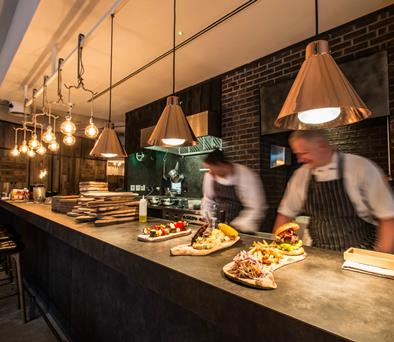The Black Bull in the village of Blidworth can trace its history as an ale house back to the…
Newstead Abbey and Lord Byron

Explore a beautiful Nottinghamshire mansion south of Mansfield, that was once home to the English Romantic poet Byron.
5.75 miles (9.2kms)
About the walk
Newstead Abbey was established by Henry II in the late 12th century, supposedly in atonement for the murder of Thomas à Becket at Canterbury, and the elegant remains of the priory church alone would be reason enough to visit today. However, in 1540 Newstead was handed over to the Byron family by another King Henry not so enamoured by the pious monks, and 250 years later it came into the possession of George Gordon, the 6th Lord Byron and celebrated English Romantic poet.
Mad, bad and dangerous to know
The Newstead that Byron inherited was empty and dilapidated, thanks to the profligate 5th Lord who had run up huge debts, so he furnished just a few rooms and used the empty ones to indulge his passion for boxing, fencing and pistol shooting, and letting his animals run wild (including dogs, tortoises, and at one stage even a bear!).
The restless young man had a string of tempestuous relationships, and in 1816 moved to Italy to travel Europe in search of love, freedom and inspiration for his poetry. He was a great champion of liberty and throwing off the shackles of tyranny, once writing an impassioned piece about the treatment of English factory workers, and his final year was spent in Greece leading local freedom fighters. Byron's work continues to be read and quoted to this day – during the Solidarity strike in Poland in the 1980s and by the protesting students at Tiananmen Square in China a decade later.
When Byron disposed of Newstead Abbey in 1817 it passed through several different owners before being presented to Nottingham Corporation in 1931. Today its grand rooms, halls and libraries are open to the public at weekends year-round, and there are fascinating displays which give an informative insight into the illustrious Byron family, including letters, furniture and other possessions that belonged to the poet. In addition to the later Victorian furnishings there are period costumes and also reproduction clothes which you are invited to try on.
Behind the house is a spread of lakes, lawns and formal gardens (from a Japanese garden through to the monks' garden and rose garden), plus a picnic area and children's playground. In all the park extends for 300 acres (121ha) and is open all year round.
Allow at least an hour to do justice to the house, and the same again to walk around the beautiful gardens. It is important to note that the car park is locked at the end of each day (check precise time on noticeboard). If you do not plan to visit the house and gardens, it may be better to park free of charge in Linby and start the walk from there.
Walk directions
From the main car park walk down the drive the short distance to the abbey, then on along the tarmac lane below the large Upper Lake. Follow this easy route for 1.25 miles (2km) until you leave the perimeter of the park after the second lodge.
Immediately turn left for a small, dumpy hill adorned with young trees (Freckland Wood). An airy and quite easy path runs up and across its panoramic top, or else you can skirt its right-hand foot on the waymarked National Cycle Network Route 6. Both routes meet up on the far corner for a direct 1.25-mile (2km) track all the way to Linby.
Turn left when you emerge close to the roundabout, and walk along the pavement through the village as far as the Horse & Groom pub. Cross over to inspect the notice board by the bus stop detailing the village's history, then continue eastwards out of the village on the pavement opposite the second of two medieval road-side crosses.
At the 50mph signs cross over once more and take a popular local footpath across Church Plantation. Continue across the River Leen, then halfway up the next field go through the archway in the hedge on the left to reach the tiny Church of St James. Leave the churchyard, via the main gate, and proceed down the surfaced drive to the main road. Turn left and walk along the pavement for 550yds (503m) until the entrance for Papplewick Hall.
Turn left, not to enter the hall's gated driveway but for the wide, semi-surfaced Hall Lane that runs via a green gate past Top Farm. Where the lane bends sharply left, around a prominent brick wall, go straight on, then fork right on the hedged farm track across the fields. Where the farm track turns right to Newstead Grange, go straight on along the main grassy track towards the wooded perimeter of the park.
Follow the waymarkers around the lodge and continue along a surfaced drive through the trees – look out for some ancient beech and oak along the way. About 0.75 miles (1.2km) beyond the lodge, the lane bends left and the path branches off ahead/right, clearly indicated. Soon it drops down to reach the main drive to the abbey.
Turn left and walk along the road to the car park and abbey for some well-earned refreshments, and perhaps a spot of poetry.
Additional information
Firm, uncomplicated paths and tracks
Parkland, woodland and villages
Good, but under close control in grounds and gardens
OS Explorer 270 Sherwood Forest
Newstead Abbey car park, access from A60 (note closing times)
At Newstead Abbey
WALKING IN SAFETY
Read our tips to look after yourself and the environment when following this walk.
Find out more
Also in the area
About the area
Discover Nottinghamshire
Most people associate Nottinghamshire in the East Midlands with the legend of Robin Hood, though the former royal hunting ground of Sherwood Forest has been somewhat tamed since Robin’s outlaw days. Traditionally, the county’s primary industry, alongside agriculture, was coal mining but it is also an oil producing area, and during World War II produced the only oil out of reach of the German U-Boats.
The county is divided between the old coalfields north of the city of Nottingham, the commuter belt of the Wolds to the south, Sherwood Forest and the great country estates known as the ‘Dukeries’. Towns of note are the river port and market town of Newark, which hosts major antiques fairs six times a year, and Southwell, known for the medieval minster with exquisite carvings of Sherwood Forest.
D H Lawrence was a Nottinghamshire man, born in Eastwood, the son of a miner and former schoolteacher. He grew up in poverty, and his book Sons and Lovers reflects the experiences of his early years. Other Nottinghamshire notables include Thomas Cranmer, the first Protestant Archbishop; Jesse Boot, founder of the Boots pharmaceutical company; Henry Ireton, the man who singed Charles I’s death warrant; and Olympic skaters Torvill and Dean.
Nearby stays
Restaurants and Pubs
Nearby experiences
Recommended things to do
Why choose Rated Trips?
Your trusted guide to rated places across the UK
The best coverage
Discover more than 15,000 professionally rated places to stay, eat and visit from across the UK and Ireland.
Quality assured
Choose a place to stay safe in the knowledge that it has been expertly assessed by trained assessors.
Plan your next trip
Search by location or the type of place you're visiting to find your next ideal holiday experience.
Travel inspiration
Read our articles, city guides and recommended things to do for inspiration. We're here to help you explore the UK.


















